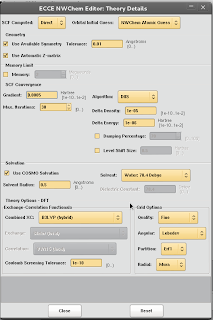1. There's a whole new type of calculation added, called 'Condensed Phase Reaction Study':
The previous reaction module has been renamed 'Gas Phase Reaction Study'. The real difference between the two types is that the Condensed Phase module uses the plan wave module in NWChem and thus uses explicit solvation, while the Gas Phase reaction module uses DFT/MP2. The latter can obviously use implicit solvation if requested.
2. The Def2-series of basis sets (Weigen and Alrichs, Phys. Chem. Chem. Phys, 2005, 7, 3297-3305) have been added to ECCE, and tools for adding basis sets on your own are now distributed with the ECCE sources. One of them is based on http://sourceforge.net/projects/nwbas2ecce/ , the scripts of which have been renamed gbsNWChemConverter and gsbDescriber. To add new basis sets, look at scripts/gbs.README in the ecce source directory, or in apps/scripts/gbs.REAME in the installation directory.
3. The precision of basis sets explicitly defined using coefficients and exponents has been greatly increased. Before, the energies obtained using the implicit nwchem basis sets and those obtained by defining the basis set through exponents and coefficients in the input could differ by 0.1 milli-Hartree in extreme cases. That should no longer be the case.
4. The COSMO parameter Rsolv can now be set in the Theory dialogue.
5. Other
There are other, non-obvious changes under the hood, such as an updated (2.2.25) apache httpd. The realease notes detail most of these.
Note that ECCE only runs on linux, and uses python 2.7. I haven't had much luck compiling it on Arch (due to python 3 seemingly being the default in Arch), but it runs fine on Debian Squeeze, Wheezy and Jessie, Fedora 18 and Scientific Linux 6.4 and Ubuntu something-or-other.
To install the binaries:
Note that there are only 64 bit binaries available. If you want to use ECCE on a 32 bit OS, you can, but you will have to compile the sources yourself. Luckily, this is very easy. Until I make a separate post, see here: http://verahill.blogspot.com.au/2013/01/325-compiling-ecce-64-on-debian-testing.html
To get the binaries (or sources) go to http://ecce.pnl.gov/using/download.shtml
Give your email and name so that the PNNL can track the number of users, as these things often impact on funding for different projects.
On the next page, select the version to download. Most likely you want the full binaries: install_ecce.v7.0.rhel5-gcc4.1.2-m64.csh
Download that file to e.g. ~/Downloads, and fire up your terminal -- in my case I'm doing an upgrade from a pre-release version of ECCE 7.0:
sudo apt-get install csh openjdk-7-jre csh install_ecce.v7.0.rhel5-gcc4.1.2-m64.cshExtracting ECCE distribution from install_ecce.v7.0.rhel5-gcc4.1.2-m64.csh... Main ECCE installation menu =========================== 1) Help on main menu options 2) Prerequisite software check 3) Full install 4) Full upgrade 5) Application software install 6) Application software upgrade 7) Server install 8) Server upgrade IMPORTANT: If you are uncertain about any aspect of installing or running ECCE at your site, please refer to the detailed ECCE Installation and Administration Guide at http://ecce.pnl.gov/docs/installation/2864B-Installation.pdf Hitat prompts to accept the default value in brackets. Selection: [1] Host name: [beryllium] New application installation directory: [/home/verahill/tmp/ecce/7.0-rc_final/ecce-v7.0/apps] Existing application directory to upgrade: New server installation directory: [/home/verahill/.ecce/e-v7.0b/server] Existing server directory to upgrade: Backup existing server user data (yes/no)? [yes] Yes ECCE v7.0 will be installed using the settings: Installation type: [full upgrade] Host name: [beryllium] Application installation directory: [/home/verahill/.ecce/ecce-v7.0b/apps] Application directory to upgrade: [/home/verahill/.ecce/ecce-v7.0/apps] Server installation directory: [/home/verahill/.ecce/ecce-v7.0b/server] Server directory to upgrade: [/home/verahill/.ecce/ecce-v7.0/server] Backup existing server user data: [yes] Are these choices correct (yes/no/quit)? [yes] Installing ECCE application software in /home/verahill/.ecce/ecce-v7.0b/apps... Extracting application distribution... Extracting NWChem distribution... Extracting client WebHelp distribution... Configuring application software... Configuring NWChem... Installing ECCE server in /home/verahill/.ecce/e-v7.0b/server... Extracting data server in /home/verahill/.ecce/e-v7.0b/server/httpd... Extracting data libraries in /home/verahill/.ecce/e-v7.0b/server/data... Extracting Java Messaging Server in /home/verahill/.ecce/e-v7.0b/server/activemq... Configuring ECCE server... Copying user data from server to be upgraded... Copying share data from server to be upgraded... ECCE installation succeeded. *************************************************************** !! You MUST perform the following steps in order to use ECCE !! -- Unless only the user 'verahill' will be running ECCE, start the ECCE server as 'verahill' with: /home/verahill/.ecce/e-v7.0b/server/ecce-admin/start_ecce_server -- To register machines to run computational codes, please see the installation and compute resource registration manuals at http://ecce.pnl.gov/using/installguide.shtml -- Before running ECCE each user must source an environment setup script. For csh/tcsh users add this to ~/.cshrc: if ( -e /home/verahill/.ecce/e-v7.0b/apps/scripts/runtime_setup ) then source /home/verahill/.ecce/e-v7.0b/apps/scripts/runtime_setup endif For sh/bash users, add this to ~/.profile or ~/.bashrc: if [ -e /home/verahill/.ecce/e-v7.0b/apps/scripts/runtime_setup.sh ]; then . /home/verahill/.ecce/e-v7.0b/apps/scripts/runtime_setup.sh fi ***************************************************************
Edit your ~/.bashrc and add the following lines (edited for your system):
You can then start ecce by typing...ecce.export ECCE_HOME=/home/verahill/.ecce/ecce-v7.0b/apps alias stopecce='/home/verahill/.ecce/ecce-v7.0b/server/ecce-admin/stop_ecce_server' alias startecce='/home/verahill/.ecce/ecce-v7.0b/server/ecce-admin/start_ecce_server'







